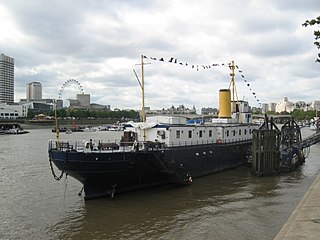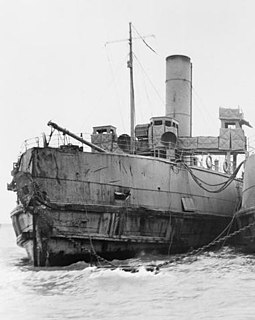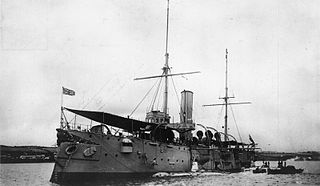 W
WHM Trawler Alvis was a British trawler that was taken up from trade and used by the Royal Navy during the Second World War. She was returned to the fishing industry at the end of hostilities in 1945.
 W
WHMS Ambrose was a cargo and passenger liner bought by the Admiralty from the Booth Steamship Company early in World War I and converted into an armed merchant cruiser. Later in the war she was converted into a submarine depot ship and spent most of the 1920s supporting submarines in the Far East. Upon her return home in 1928, Ambrose was placed in the Reserve Fleet. She was later modified to support destroyers and did so throughout World War II before she was sold for scrap in 1946.
 W
WHMS Antelope was a Royal Navy Alarm-class torpedo gunboat. She was launched in 1893, reduced to harbour service from 1910 and was sold for scrapping in 1919.
 W
WRMS Atrato was a UK steamship that was built in 1888 as a Royal Mail Ship and ocean liner for the Royal Mail Steam Packet Company. In 1912 she was sold and became the cruise ship The Viking. Toward the end of 1914 she was requisitioned and converted into the armed merchant cruiser HMS Viknor. She sank in 1915 with all hands, a total of 295 Royal Navy officers and men.
 W
WHMS Cyclops (F31) was a submarine repair and depot ship of the Royal Navy. She was originally the passenger liner Indrabarah sister ship to Indralema, built by Laing, for the Indra Line Ltd then bought by The Admiralty, while she was building. She was launched on 27 October 1905.
 W
WPS Duchess of Montrose was a paddle steamer launched in 1902 and operated by the Caledonian Steam Packet Company as a River Clyde excursion steamer. She saw active service during the First World War after being requisitioned by the Admiralty and converted into a minesweeper. She was lost near Dunkirk on 18 March 1917 after striking a mine.
 W
WHMS Fifi was an armed screw steamer, captured from the Germans by Royal Navy units during the Battle for Lake Tanganyika, and used to support Anglo-Belgian operations on the lake and its surrounding areas. She had previously been operated by the Germans under the name Kingani named after the river Kingani.
 W
WHM Trawler Force was a British trawler built for the Royal Navy in the First World War and subsequently requisitioned for service in the Second World War. She was sunk by air attack in June 1941.
 W
WSS Kavirondo was a steam tug on Lake Victoria in East Africa. She was named after a local Lake Victoria region and was one of many compact Lake Victoria steamships operated by the Uganda Railway.
 W
WA naval drifter is a boat built along the lines of a commercial fishing drifter but fitted out for naval purposes. The use of naval drifters is paralleled by the use of naval trawlers.
 W
WHMS Pomone was a Pelorus-class protected cruiser built for the Royal Navy in the late 1890s. The ship's boilers were so troublesome that she was decommissioned in 1904 after only a single foreign deployment. She was hulked in 1910 and served as a stationary training ship until 1922 when she was sold for scrap.
 W
WHMS President (1918) is a retired Flower-class Q-ship that was launched in 1918. She was renamed HMS President in 1922 and moored permanently on the Thames as a Royal Navy Reserve drill ship. In 1982 she was sold to private owners, and having changed hands twice, now serves as a venue for conferences and functions, and serves as the offices for a number of media companies. She had the suffix "(1918)" added to her name in order to distinguish her from HMS President, the Royal Naval Reserve base in St Katharine Docks. She is one of the last three surviving Royal Navy warships of the First World War. She is also the sole representative of the first type of purpose built anti-submarine vessels, and is the ancestor of World War II convoy escort sloops, which evolved into modern anti-submarine frigates.
 W
WHMS Prize was a schooner converted to a Q ship during the First World War and commanded by Lieutenant William Sanders of the Royal Naval Reserve.
 W
WSS Royal Daffodil was a Mersey ferry, built in 1906 and scrapped in 1938. She was built as Daffodil but renamed Royal Daffodil in recognition of her service under requisition during the 1st World War.
 W
WSS Royal Iris was a Mersey Ferryboat built in 1906 for Wallasey Corporation. She was built as Iris for service on the River Mersey. In 1918 she was requisitioned by the Royal Navy for action during the Zeebrugge Raid. She was renamed Royal Iris in recognition of her part in this action and returned to civilian duties. She was sold in 1931 and renamed Blarney in 1946. She was scrapped in December 1961.
 W
WHMS President (1918) is a retired Flower-class Q-ship that was launched in 1918. She was renamed HMS President in 1922 and moored permanently on the Thames as a Royal Navy Reserve drill ship. In 1982 she was sold to private owners, and having changed hands twice, now serves as a venue for conferences and functions, and serves as the offices for a number of media companies. She had the suffix "(1918)" added to her name in order to distinguish her from HMS President, the Royal Naval Reserve base in St Katharine Docks. She is one of the last three surviving Royal Navy warships of the First World War. She is also the sole representative of the first type of purpose built anti-submarine vessels, and is the ancestor of World War II convoy escort sloops, which evolved into modern anti-submarine frigates.
 W
WUSS St. Francis (ID-1557) was a freighter built for the Isthmian Steamship Company, of London, England, a subsidiary of United States Steel Corporation, prior to World War I. She was acquired by the US Navy for use during the war.
 W
WHMS Thames was a Mersey-class protected cruiser built for the Royal Navy (RN) in the 1880s. The ship was placed in reserve upon her completion in 1888 and was converted into a submarine depot ship in 1903. She was sold out of the navy in 1920 and was purchased by a South African businessman to serve as a training ship for naval cadets under the name SATS General Botha. The ship arrived in South Africa in 1921 and began training her first class of cadets in Simon's Town the following year. General Botha continued to train cadets for the first several years of World War II, but the RN took over the ship in 1942 for use as an accommodation ship under her original name. She was scuttled by gunfire in 1947 and is now a diveable wreck.
 W
WHMS Thistle was a Bramble-class gunboat of the Royal Navy, launched in 1899 and broken up in 1926. She is notable for being the last classic Victorian gunboat, and the last British warship to retain a practical sailing rig.
 W
WThe Viola is a steam trawler built in 1906 at Hull. She is the oldest surviving steam trawler in the world. During her long career, she was known as HMT Viola, Kapduen, and Dias. She is currently beached at Grytviken in South Georgia, though there are currently plans afoot to return her to Hull.